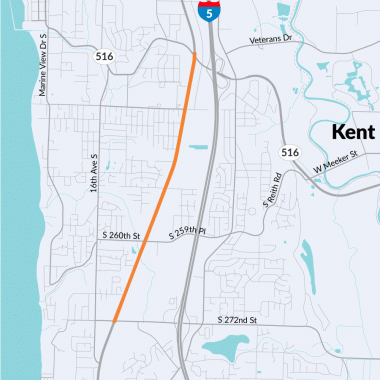Project overview
This project will resurface the northbound and southbound lanes of State Route 99 from South 272nd Street to SR 516 to extend the pavement service life. Crews will grind and inlay new Hot Mix Asphalt (HMA), perform pavement repair, traffic loop replacement, striping and traffic control. Pedestrian curb ramps will be evaluated and updated as necessary to meet the Americans with Disabilities Act and current accessibility standards. Additionally, this project is subject to WSDOT’s Complete Streets requirements. We will be working to incorporate as much active transportation facilities as feasible within the project delivery timelines. However, it is likely some active transportation facilities needed to meet the Complete Streets requirement will be implemented at a later date. This project will also require an Environmental Justice Assessment.
What to expect
During construction, crews will grind the road surface and inlay new HMA. Work will primarily be performed at night. Throughout the project, travelers can expect directional and double-lane closures along SR 99. Single-lane closures at some locations for curb ramp construction are possible.
Environmental justice assessment
An Environmental Justice Assessment (EJA) will be completed for this project. These assessments are conducted for significant agency actions (SAAs) that could harm the environment or impact how environmental benefits are distributed to overburdened communities (OBCs) or vulnerable populations (VPs). An EJA guides decision-making to ensure a fair distribution of environmental benefits, reduce environmental harms, and address disparities in environmental and health outcomes. Meaningful engagement with affected communities is a crucial aspect of this process.
This project will pave and make ADA improvements in both directions of SR 99 from South 272nd Street to SR 512.
This stretch of SR 99 was first opened in 1927, and today, 30,000 travelers use the roadway daily. The road was last paved in 2008.
Complete Streets
Complete Streets means planning, designing, and operating transportation facilities that meet the needs of all modes of transportation. Using WSDOT’s Complete Streets approach, this project will go through a pre-design phase to develop alternatives that enable comfortable and convenient access for pedestrians, bicyclists and transit users traveling along and across SR 99. The pre-design phase of the project will include community engagement to understand the needs of tribes, overburdened communities, multimodal users, residents and other interested parties in the area.
The intent of the SR 99—South 272nd St to SR 516 Complete Streets Pre-Design phase is to create a corridor that accommodates all modes of travel while improving active transportation connections and expanding options for non-drivers, making travel more predictable for all users.
Healthy Environment for All (HEAL) Act
This project is also subject to Washington's environmental justice law, known as the Healthy Environment for All (HEAL) Act. Environmental justice in Washington State, as provided in the HEAL Act, addresses disproportionate environmental and health impacts in all laws, rules and policies by prioritizing vulnerable populations and overburdened communities, the equitable distribution of resources and benefits, and eliminating harm (RCW 70A.02.010).
Agency/Partner Coordination and Meetings
We intend to set-up working groups with agencies and partners to provide technical feedback and inform WSDOT during the Complete Streets pre-design process.
Community Engagement
Community engagement will be conducted throughout the project. Specific engagement opportunities will be updated as the project advances.
Working groups
Technical Working Group (TWG)
The TWG consists of public works, engineering, and planning staff from local, regional, state and tribal entities. The TWG serves in an advisory role to WSDOT providing technical feedback at multiple steps in the pre-design process.
Technical Working Group Meeting 1
Friday, March 7, 2025
Presentation (PDF 5MB)
Summary (PDF 191 KB)
Technical Working Group Meeting 2
Friday, July 31, 2025
Presentation (PDF 4MB)
Summary (PDF 159KB)

